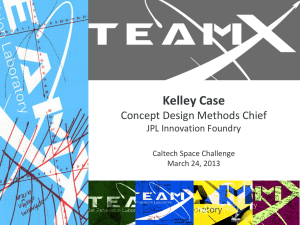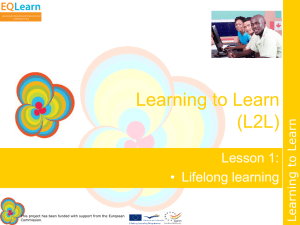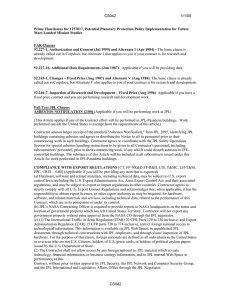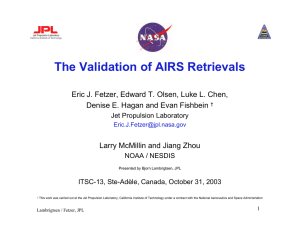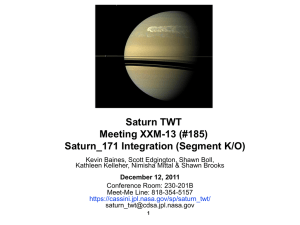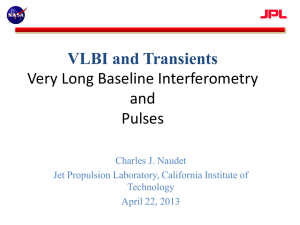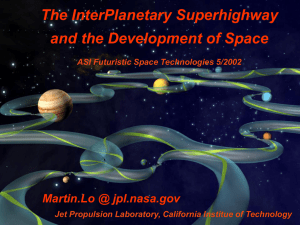Back To Basics - Workshop on Spacecraft Flight Software
advertisement
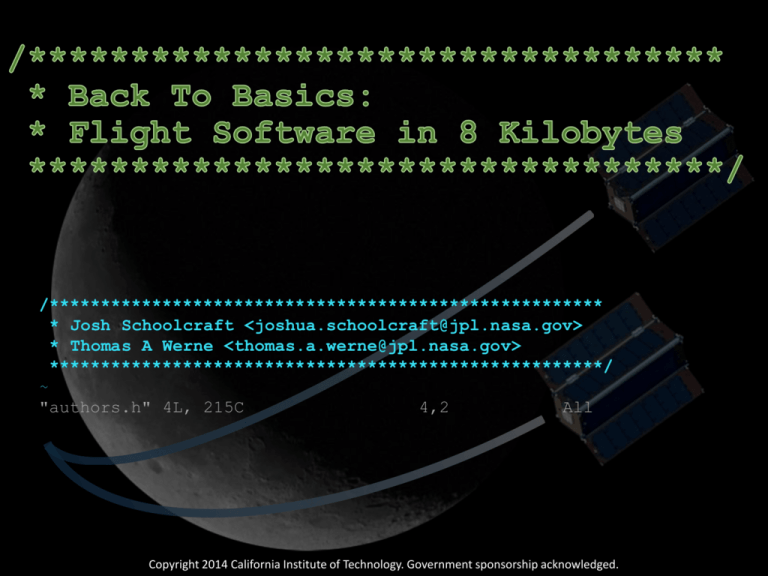
/****************************************************** * Josh Schoolcraft <joshua.schoolcraft@jpl.nasa.gov> * Thomas A Werne <thomas.a.werne@jpl.nasa.gov> ******************************************************/ ~ "authors.h" 4L, 215C 4,2 All Copyright 2014 California Institute of Technology. Government sponsorship acknowledged. “If you want to make an apple pie from scratch, you must first create the universe.” 2 \mainpage • Intro • INSPIRE • Architectures • Development • The Code • Reflections 3 \people • Communications Networks • Instrument Flight Software and Ground Support • Instrument Flight Software and Ground Support 4 Interplanetary NanoSpacecraft Pathfinder In a Relevant Environment Low-cost mission leadership with the world’s first CubeSat beyond Earth-orbit PI: Dr. Andrew Klesh, Jet Propulsion Laboratory, California Institute of Technology PM: Ms. Lauren Halatek, Jet Propulsion Laboratory, California Institute of Technology University Partners: • Cal Poly - San Luis Obispo • U. California – Los Angeles • U. Michigan – Ann Arbor • U. Texas – Austin Collaborator: • Goldstone-Apple Valley Radio Telescope (GAVRT) Copyright 2014 California Institute of Technology. Government sponsorship acknowledged. 5 \INSPIRE Overview: X-Band Patch Antennas (JPL) [two sets] ISIS UHF Antenna Volume: 3U (10x10x30cm) Data Rate: 62-256000 bps Magnetometer (JPL) Communications: Primary: X-band via DSN Secondary (Receive only): DSS-28 (GAVRT), & Secondary Stations Relay: UHF Cold-Gas ACS (U. Texas) Star Tracker (Blue Canyon) Science: Magnetometer Camera + Processing Board C&DH Board + Lithium UHF (AstroDev) Processing Board (Tyvak) Guidance and Control: Star Tracker Gyroscope Sun Sensors / Solar Cells Cold-Gas Thrusters Deployable Solar Panels (Pumpkin) Structure (JPL) Iris X-Band Radio (JPL) 6 \INSPIRE • Small project (<$5.5M) with small focused team (core of 9 people) for short mission duration (<90 days) in deep space with redundant spacecraft. • Development: 18 months from start to finish • Delivered on time and under budget • Built on extensive CubeSat experience in low-Earth orbit (personnel, practices, and hardware heritage) • Small, skilled, multidisciplinary team • Use existing standards (CubeSat Specification, CCSDS, etc.) to reduce design complexity • Large margin for mission success based on demonstrated capabilities 7 \requirements • Survive • Navigate • Communicate …Everything else is extra credit… 8 \constraints • Time • People • Hardware …Everything else is secondary… 9 \hardware architecture • Texas Instruments MSP430 family • Extremely low power (idle current <1µA) • Von-Neumann architecture • JTAG debug (single-step instructions with full hardware state visibility) • Not radiation-hardened (yet) 10 \hardware architecture • Initial design: MSP430F1611 • Flight Heritage • 8MHz, 10KB SRAM, 64KB program storage • Final design: MSP430F2618 • 16MHz 8KB SRAM, 116KB Program storage • 16-bit architecture with 20-bit addressing • Bus Interfaces: I2C, SPI, UART 11 \software architecture • Organic approach • Start with a minimal, rock-solid “universe” • Core real-time operating system “protos” • • • • Time Threads Memory protection Cascaded deadline enforcement • Establish bus communication • Read and track hardware state 12 \software architecture • Integrate off-the-shelf ground software • AMMOS Mission Data Processing and Control System (AMPCS) • Establish mission-specific framework • Support tests with increasing complexity • Start with peripherals on/off (blinkenlights) • End with Operational Readiness Tests (and the mission) 13 \development • Pair coding (“rolling peer reviews”) • Start from bare metal, add functionality only as needed • Expect to write subsystems three times: 1. 2. 3. Prototype First cut Final cut • Work with real hardware • Write and test in a tight loop • • End-to-end as much as possible with ground software in the loop Use bug reporting for problems that require discussion and planning • Spend time to save time • • • Instrument everything (“Breadcrumbs”), trust nothing Maintain some modularity Automate repetitive tasks • Leverage autocoding • Build from tables as much as possible • Python + YAML (not XML) • Simplifiy hardware checkouts • Interactive RUSH: Really Useful SHell Merge the CubeSat software development model (amateur code, fast and loose) with guidance from the agile software development, and a helping of skepticism. 14 \nutshell • Coded ~99% from scratch • Fault Protection engine • Multi-threaded RTOS (“protos”) • Attitude control • Drivers for 14 hardware devices • DSN-conformant telecom library • Protocols: AOS, TC, Space Packet, CFDP-1, AX.25 • Uplink, downlink, relay • FAT32 filesystem • Command sequence engine • Simultaneous execution • Mission modes • Science Campaigns • Hotfix patching • Ground support tools • Umbilical interface • Autocoded command and telemetry stubs • Patch generator • Sequence generator • CFDP Depacketizer 15 \codebase • C (with C99 initializers): 15,000 lines (cloc) • Libraries - Drivers, Filesystem, Telecom: 50% • Mission-specific software: 35% • Core protos OS: 15% • Assembly: 50 lines • Stack - register manipulation • 20-bit address manipulations • Texas Instruments cl430 compiler • O2, small_enum, LARGE_CODE_MODEL • 100KB binary, including reserved spaces 16 \runtime • Stack: 2KB • 80% utilization at deepest call depth • Four threads, “executive” round-robin scheduler • Telecom buffers: 4KB • Three multi-protocol I/O interfaces: Two radios + ground umbilical • Spacecraft state: 1KB • SD card driver: 512B 17 \critical points • • • • Stable core Breadcrumbs Automation Hardware in the loop • Tight write-test-modify loop 18 \parallels “The original software development for the data computer has essentially been a two-man show since 1975, beginning when Edgar M. Blizzard joined Richard Rice to develop the flight version of the code. […] From start to validation to release, their tools were within sight, and certainly hearing […]. Rice characterized the unique nature of the computer data software this way: ‘We didn’t worry about top-down or structured; we just defined functions.’” -Encyclopedia of Computer Science and Technology Vol. 18 “Computers In Spaceflight: The NASA Experience” 19 ^[:q!
